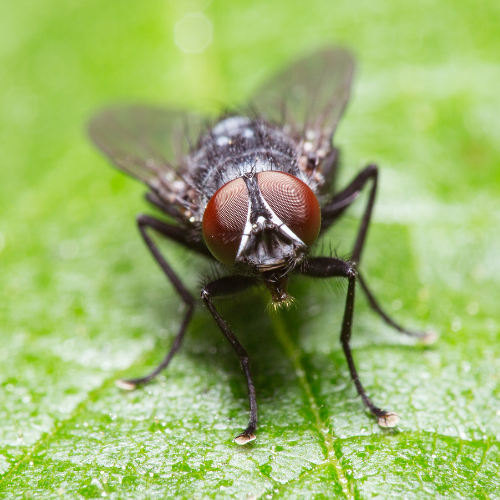Cluster Fly

Proud Supporter of Disabled Veterans
No Contracts
Services provided without written contracts.
Introduction to
Cluster flies, also known as attic flies, are a common nuisance in homes and buildings, particularly during the cooler months. These flies belong to the genus Pollenia and are larger and slower than the typical housefly. Cluster flies get their name from their tendency to cluster together in large numbers, often in attics, lofts, and unused rooms. While they do not pose a direct health risk, their presence can be unsettling and their sluggish movement makes them easy to spot. Understanding the biology, habits, and effective prevention methods for cluster flies is essential for managing infestations and maintaining a comfortable living environment.
Recognition
Cluster flies are larger than houseflies, typically measuring 8-10 mm in length. They have a dark gray to black body with golden-yellow hairs on their thorax, giving them a slightly bristly appearance. Their wings overlap when at rest, and they have a distinctive sluggish flight pattern. Unlike houseflies, cluster flies do not have metallic coloring and their eyes are not as prominent. The presence of cluster flies is often noted by their tendency to gather in large numbers, particularly in attics, around windows, and in unused rooms.
Biology
Cluster flies undergo complete metamorphosis, progressing through four life stages: egg, larva, pupa, and adult. Female cluster flies lay their eggs in soil, where the larvae parasitize earthworms, feeding on their host before pupating in the soil. Adult flies emerge in late summer and seek out warm, sheltered areas to overwinter. They enter buildings through cracks and crevices, often congregating in attics, wall voids, and unused rooms. During the winter, cluster flies remain dormant but become active on warm, sunny days. Their lifecycle is closely tied to seasonal changes, with adults becoming particularly noticeable in spring and fall.
Habits
Cluster flies are primarily outdoor insects but seek shelter indoors to overwinter. They prefer warm, sunny locations and are commonly found in attics, lofts, and around windows. Cluster flies are not attracted to human food or waste; instead, they feed on nectar and other plant materials. Their sluggish movement and tendency to cluster together make them easy to spot. While they do not breed indoors, their presence can be a nuisance, particularly when they become active during warm spells in winter or early spring.
Prevention
Preventing cluster fly infestations involves sealing entry points and reducing their access to indoor overwintering sites. Seal cracks and crevices around windows, doors, and eaves with caulk or weather stripping. Ensure that screens on windows and vents are intact and properly fitted. Use fine mesh screens on attic vents and other potential entry points. Reduce outdoor lighting during peak migration periods to avoid attracting flies. Vacuum up any cluster flies that appear indoors and dispose of them promptly. Regularly inspect and maintain the exterior of your home to prevent entry.
Professional
If cluster flies become a persistent problem, professional pest control services can provide effective solutions. STL Pest Control offers comprehensive treatments to eliminate cluster fly populations from homes and commercial establishments. Their technicians are trained to identify entry points and apply appropriate treatments, including insecticidal dusts, sprays, and integrated pest management techniques. In severe cases, they may recommend ongoing maintenance plans to keep cluster fly populations under control. Professional services ensure thorough and long-lasting control, providing peace of mind and a more comfortable living environment.



Our Office







